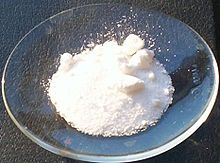
| |

| |
| Names | |
|---|---|
Other names
| |
| Identifiers | |
3D model (JSmol)
|
|
| ChEBI | |
| ChEMBL | |
| ECHA InfoCard | 100.028.794 |
| EC Number |
|
| E number | E223 (preservatives) |
PubChem CID
|
|
| RTECS number |
|
| UNII | |
CompTox Dashboard (EPA)
|
|
| |
| |
| Properties | |
| Na2S2O5 | |
| Molar mass | 190.107 g/mol |
| Appearance | White to yellow powder |
| Odor | Faint SO2 |
| Density | 1.48 g/cm3 |
| Melting point | 170 °C (338 °F; 443 K) decomposition begins at 150 °C |
| |
| Solubility | Very soluble in glycerol Slightly soluble in ethanol |
| Hazards | |
| GHS labelling: | |
 
| |
| Danger | |
| H302, H318 | |
| P264, P270, P280, P301+P312, P305+P351+P338, P310, P330, P501 | |
| NFPA 704 (fire diamond) | |
| NIOSH (US health exposure limits): | |
PEL (Permissible)
|
None[1] |
REL (Recommended)
|
TWA 5 mg/m3[1] |
IDLH (Immediate danger)
|
N.D.[1] |
| Safety data sheet (SDS) | Mallinckrodt MSDS |
| Related compounds | |
Other anions
|
Sodium sulfite Sodium bisulfite |
Other cations
|
Potassium metabisulfite |
Related compounds
|
Sodium dithionite Sodium thiosulfate Sodium sulfate |
Except where otherwise noted, data are given for materials in their standard state (at 25 °C [77 °F], 100 kPa).
| |
Sodium metabisulfite or sodium pyrosulfite (IUPAC spelling; Br. E. sodium metabisulphite or sodium pyrosulphite) is an inorganic compound of chemical formula Na2S2O5. The substance is sometimes referred to as disodium metabisulfite. It is used as a disinfectant, antioxidant, and preservative agent.[2] When dissolved in water it forms sodium bisulfite.
- ^ a b c NIOSH Pocket Guide to Chemical Hazards. "#0566". National Institute for Occupational Safety and Health (NIOSH).
- ^ Barberá, José Jiménez; Metzger, Adolf; Wolf, Manfred (2000). "Sulfites, Thiosulfates, and Dithionitesl Chemistry". Ullmann's Encyclopedia of Industrial Chemistry. Weinheim: Wiley-VCH. doi:10.1002/14356007.a25_477. ISBN 3527306730.
